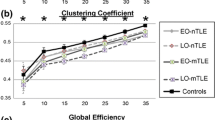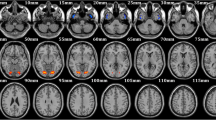Objectives. To identify the pattern of functional connectivity (FC) between areas and networks in the brain in patients with frontal and temporal foci of epileptic activity. Materials and methods. A total of 43 patients aged 18–50 years with focal epilepsy – 32 with temporal epilepsy (TE) and 11 with frontal epilepsy (FE) – were studied. The control group consisted of 32 healthy subjects. The main method used in the study was brain MRI scans run using the epilepsy protocol and additionally including high-resolution structural images of the brain, along with resting-state fMRI. Results and conclusions. The most marked fMRI feature in patients with TE as compared with healthy subjects was a decrease in the FC of the insular cortex and the temporal opercula (the part of the temporal gyrus of each hemisphere overhanging the insula). In left-sided FE, the decrease on the left was significant. Increased FC in the dorsal part of the attention network on the left with the temporal and parietal areas of the cerebral cortex was specific for right-sided TE. TE also produced a decrease in FC between the anterior part of the cingulate gyrus and the basal ganglia. All significant results were linked with increases in FC in patients with FE as compared with healthy subjects, maximally in areas of the temporal cortex. Thus, the localization and lateralization of the focus of epileptic activity determine the pattern of FC in these areas and neural networks of the brain in patients with focal epilepsy.
Similar content being viewed by others
References
S. Wiebe, “Epidemiology of temporal lobe epilepsy,” Can. J. Neurol. Sci., 27, Suppl. 1, 6–10 (2000).
B. Diehl and J. S. Duncan, “Temporal lobe epilepsy,” in: Epilepsy 2017: From Benchside to Bedside. A Practical Guide to Epilepsy. Lecture Notes from the Sixteenth Epilepsy Teaching Weekend, F. J. Rugg-Gunn and H. B. Stapley (eds.), UCL Institute of Neurology, Oxford (2017).
R. Thornton, S. Vulliemoz, R. Rodionov, et al., “Epileptic networks in focal cortical dysplasia revealed using electroencephalography-functional magnetic resonance imaging,” Ann. Neurol., 70, No. 5, 822–837 (2011), https://doi.org/10.1002/ana.22535.
B. Biswal, F. Z. Yetkin, V. M. Haughton, and J. S. Hyde, “Functional connectivity in the motor cortex of resting human brain using echo-planar MRI,” Magn. Reson. Med., 34, No. 4, 537–541 (1995).
J. F. Hipp and M. Siegel, “BOLD fMRI correlation refl ects frequency-specific neuronal correlation,” Curr. Biol., 25, No. 10, 1368–1374 (2015), https://doi.org/10.1016/j.cub.2015.03.049.
M. Centeno and D. W. Carmichael, “Network connectivity in epilepsy: Resting state fMRI and EEG-fMRI contributions,” Front. Neurol., 5, 93 (2014), https://doi.org/10.3389/fneur.2014.00093.
L. A. Maiorova, I. S. Samotaeva, N. N. Lebedeva, et al., “Neural network rearrangements in focal and generalized epilepsy – resting fMRI data,” Zh. Nevrol. Psikhiat., 117, No. 9–2, 4–9 (2017), https://doi.org/10.17116/jnevro2017117924-9.
K. E. Weaver, W. A. Chaovalitwongse, E. J. Novotny, et al., “Local functional connectivity as a pre-surgical tool for seizure focus identification in non-lesion, focal epilepsy,” Front. Neurol., 4, 43 (2013), https://doi.org/10.3389/fneur.2013.00043.
R. T. Constable, D. Scheinost, E. S. Finn, et al., “Potential use and challenges of functional connectivity mapping in intractable epilepsy,” Front. Neurol., 4, 39 (2013), https://doi.org/10.3389/fneur.2013.00039.
H. J. Jo, D. L. Kenney-Jung, I. Balzekas, et al., “Relationship between seizure frequency and functional abnormalities in limbic network of medial temporal lobe epilepsy,” Front. Neurol., 10, 488 (2019), https://doi.org/10.3389/fneur.2019.00488.
Q. Li, Y. Chen, Y. Wei, et al., “Functional network connectivity patterns between idiopathic generalized epilepsy with myoclonic and absence seizures,” Front. Comput. Neurosci., 11, 38 (2017), https://doi.org/10.3389/fncom.2017.00038.
C. Zhong, R. Liu, C. Luo, et al., “Altered structural and functional connectivity of juvenile myoclonic epilepsy: An fMRI study,” Neural Plast., 1–12 (2018), https://doi.org/10.1155/2018/7392187.
K. Smitha, K. Akhil Raja, K. Arun, et al., “Resting state fMRI: A review on methods in resting state connectivity analysis and resting state networks,” Neuroradiol. J., 30, No. 4, 305–317 (2017), https://doi.org/10.1177/1971400917697342.
N. N. Lebedeva, L. A. Maiorova, and I. S. Samotaeva, “The functional connectome: resting network in various neurological and psychiatric disorders,” Usp. Fiziol. Nauk., 48, No. 3, 29–44 (2017).
Z. Zhang, G. Lu, Y. Zhong, et al., “Impaired perceptual networks in temporal lobe epilepsy revealed by resting fMRI,” J. Neurol., 256, No. 10, 1705–1713 (2009), https://doi.org/10.1007/s00415-009-5187-2.
A. C. Grant, “Interictal perceptual function in epilepsy,” Epilepsy Behav., 6, No. 4, 511–519 (2005), https://doi.org/10.1016/J.YEBEH.2005.03.016.
N. Nelissen, W. Van Paesschen, K. Baete, et al., “Correlations of interictal FDG-PET metabolism and ictal SPECT perfusion changes in human temporal lobe epilepsy with hippocampal sclerosis,” NeuroImage, 32, No. 2, 684–695 (2006), https://doi.org/10.1016/J.NEUROIMAGE.2006.04.185.
A. B. Waites, R. S. Briellmann, M. M. Saling, et al., “Functional connectivity networks are disrupted in left temporal lobe epilepsy,” Ann. Neurol., 59, No. 2, 335–343 (2006), https://doi.org/10.1002/ana.20733.
G. E. Doucet, X. He, M. R. Sperling, et al., “From “rest” to language task: Task activation selects and prunes from broader resting-state network,” Hum. Brain Mapp., 38, No. 5, 2540–2552 (2017), https://doi.org/10.1002/hbm.23539.
M. M. Berl, L. A. Zimmaro, O. I. Khan, et al., “Characterization of atypical language activation patterns in focal epilepsy,” Ann. Neurol., 75, No. 1, 33–42 (2014), 10.1002/ana.24015.
Z. Zhang, G. Lu, Y. Zhong, et al., “Impaired attention network in temporal lobe epilepsy: A resting FMRI study,” Neurosci. Lett., 458, No. 3, 97–101 (2009), 0.1016/j.neulet.2009.04.040.
G. E. Doucet, C. Skidmore, A. D. Sharan, et al., “Functional connectivity abnormalities vary by amygdala subdivision and are associated with psychiatric symptoms in unilateral temporal epilepsy,” Brain Cognit., 83, No. 2, 171–182 (2013), 0.1016/j.bandc.2013.08.001.
Author information
Authors and Affiliations
Corresponding author
Additional information
Translated from Zhurnal Nevrologii i Psikhiatrii imeni S. S. Korsakova, Vol. 119, No. 11, Iss. 2, pp. 11–15, November, 2019.
Rights and permissions
About this article
Cite this article
Samotaeva, I.S., Teplyshova, A.M., Rider, F.K. et al. Patterns of Functional Connectivity in the Brain in Temporal and Frontal Epilepsy. Neurosci Behav Physi 50, 835–840 (2020). https://doi.org/10.1007/s11055-020-00975-2
Received:
Accepted:
Published:
Issue Date:
DOI: https://doi.org/10.1007/s11055-020-00975-2




